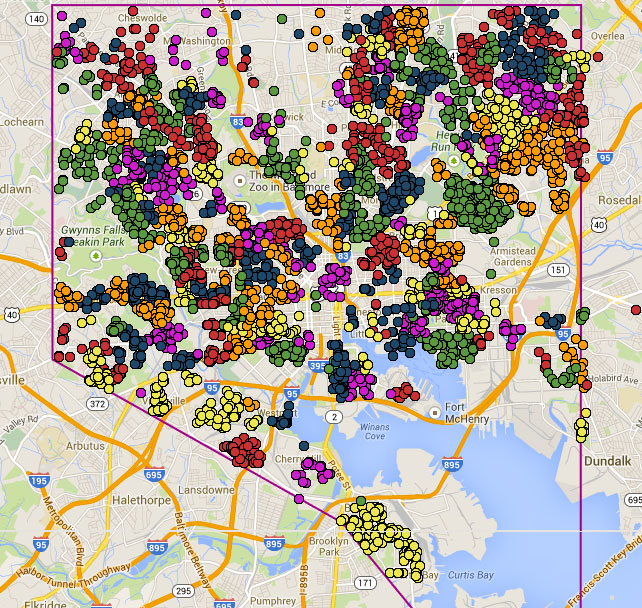For years, the Baltimore Neighborhood Indicators Alliance (BNIA) has gathered all sorts of data about life in Baltimore City. As national news reporters descended on the city in the wake of the unrest that followed Freddie Gray’s funeral, Seema Iyer saw a lot of the group’s work being cited everywhere.
At the SocEnt Breakfast held last week at the Baltimore Metropolitan Council’s offices in McHenry Row, Iyer showed a slide full of news articles that rely on the data compiled by BNIA.
“You notice that the news articles that came from Baltimore were a little bit different than the articles that came from New York and St. Louis,” Iyer said, referring to national articles about the Freddie Gray, Michael Brown and Eric Garner cases. “It was largely because they were looking at the neighborhood context.”
It’s the result of BNIA’s open data approach.
Iyer said it can be a struggle to get data from the city and state. But once the group gets it, BNIA releases it to all for use through Baltimore City’s open data portal, and its own website.
BNIA also uses the data for producing reports. The group recently released its annual Vital Signs report, which details indicators for quality of life in the city. In May, BNIA also released the Grow Baltimore report, which features analysis on migration in and out of the city.
Here are a few pieces of data that Iyer shared:
1. 5.3 percent
- That’s the number of city residents who are currently under court-ordered supervision. Re-entry after incarceration presents barriers to getting a job that go beyond having a criminal record, Iyer said. It’s also a large group of people, as thousands of people are released from prison in Baltimore City each year. “If you look at the neighborhood level, community supervision and unemployment are highly correlated,” she said. “There’s almost a 90 percent correlation.”
2. Ease of commute is important
- With only 25 percent of the jobs in the Baltimore metro area located in the city, how easy it is to get to work is an important consideration for people thinking about accessing jobs. Iyer said people who live in neighborhoods who face a commute of more than 45 minutes face a huge barrier to employment. Equally, access to a major thoroughfare was cited as a major consideration by people who were looking to buy a home in the city. “All of you probably live within a mile to an interchange,” Iyer told the three dozen people at SocEnt Breakfast.
3. Retirees are leaving the city
- In researching who is moving out of the city, BNIA researchers found that many people of retirement age were leaving. She said they were often looking to move to single-story houses that made it easier to age in place, and for areas with lower taxes. Iyer said the stat stuck out to the BNIA staff. “They just spent their whole life in the City of Baltimore, and that’s social capital we would love to have.”
Before you go...
Please consider supporting Technical.ly to keep our independent journalism strong. Unlike most business-focused media outlets, we don’t have a paywall. Instead, we count on your personal and organizational support.
3 ways to support our work:- Contribute to the Journalism Fund. Charitable giving ensures our information remains free and accessible for residents to discover workforce programs and entrepreneurship pathways. This includes philanthropic grants and individual tax-deductible donations from readers like you.
- Use our Preferred Partners. Our directory of vetted providers offers high-quality recommendations for services our readers need, and each referral supports our journalism.
- Use our services. If you need entrepreneurs and tech leaders to buy your services, are seeking technologists to hire or want more professionals to know about your ecosystem, Technical.ly has the biggest and most engaged audience in the mid-Atlantic. We help companies tell their stories and answer big questions to meet and serve our community.
Join our growing Slack community
Join 5,000 tech professionals and entrepreneurs in our community Slack today!

The person charged in the UnitedHealthcare CEO shooting had a ton of tech connections

From rejection to innovation: How I built a tool to beat AI hiring algorithms at their own game

Where are the country’s most vibrant tech and startup communities?



